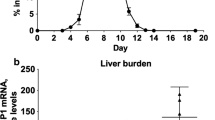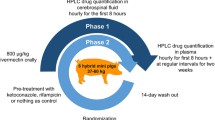Summary
Metabolism and disposition of most drugs used to treat malaria are substantially altered in malaria infection. Few data are available that specify effects of malaria infection on drug metabolism pathways in humans or animal model systems. In this report, studies were undertaken to determine the effect ofPlasmodium berghei infection on cytochrome P-450 (CYP450) 2E1 and 3A2-mediated metabolism and enzyme expression in rat liver microsomes. Malaria infection (MAL) resulted in significant decreases in total cytochrome P-450 content (56%,P<0.05) and NADPH cytochrome P-450 reductase activity (32%,P<0.05) as compared to control (CON) rats. Chlorzoxazone 4-hydroxylase activity (CYP2E1-mediated) showed no significant difference between CON and MAL microsomes while testosterone 6-\-hydroxylase activity (CYP3A2-mediated) was reduced by 41% (P<0.05) in MAL. Enzyme kinetic studies and immunoblot analysis indicate that the loss of activity for CYP3A2 in malaria infection is due to significantly decreased CYP3A2 protein expression. The altered expression of CYP450s in malaria infection should be taken into account when treating patients with malaria in order to minimize drug-drug interactions or toxicity.
Similar content being viewed by others
References
Oaks S.C., Mitchell V.S., Pearson G.W., Carpenter C.CJ. (eds) (1991): Malaria: Obstacles and Opportunities, A report of the committee for the study on malaria prevention and control: Status Review and Alternative Strategies. Division of International Health, Institute of Medicine, National Academy Press.
Na-Bangchang K., Limpaibul L. (1994): The pharmacokinetics of chloroquine in healthy Thai subjects and patients withPlasmodium vivax malaria. Br. J. Clin. Pharmacol., 38: 278–281.
White N.J., Looareesuwan S., Warrell D.A., Warrell M.J., Bunnag D., Harinasuta T. (1982). Quinine pharmacokinetics and toxicity in cerebral and uncomplicated falciparum malaria. Am. J. Med., 73: 564–571.
White N.J. (1985): Clinical pharmacokinetics of antimalarial drugs. Clin. Pharmacokinet., 10: 187–215.
Alvares A.P., Ueng T.H., Scheibel L.W., Hollingdale M.R. (1984): Impairment of hepatic cytochrome P-450 dependent monooxygenases by the malaria parasitePlasmodium berghei. Mol. Biochem. Parasitol., 13: 277–282.
Glazier A.P., Kokwaro G.O., Edwards G. (1993): Possible isozyme-specific effects of experimental malaria withPlasmodium berghei on cytochrome P450 activity in rat liver microsomes. J. Pharm. Pharmacol., 46: 352–355.
Kokwaro G.O., Glazier A.P., Ward S.A., Breckenridge A.M., Edwards G. (1993): Effect of malaria infection and endotoxin-induced fever on phenacetin O-deethylation by rat liver microsomes. Biochem. Pharmacol., 45: 1235–1241.
Mihaly G.W., Date N.M., Veenendaal J.R., Newman K.T., Smallwood R.A. (1987): Decreased hepatic elimination of pyrimethamine during malaria infection. Studies in the isolated perfused rat liver. Biochem. Pharmacol., 36: 2827–2829.
Mansor S.M., Edwards G., Roberts PJ., Ward S.A. (1991): The effect of malaria infection on paracetamol disposition in the rat. Biochem. Pharmacol., 41: 1707–1711.
Murdoch R.T., Ghabrial H., Smallwood R.A., Morgan DJ. (1992): Effect of malaria on phenol conjugation pathways in perfused rat liver. Biochem. Pharmacol., 43: 1229–1234.
Black R.H., Ray A.P. (1977): Experimental studies of the potentiation of proguanil and pyrimethamine by dapsone usingPlasmodium berghei in white mice. Ann. Trop. Med. Parasitol., 71: 131–139.
Guengerich E.P. (1977): Separation and purification of multiple forms of microsomal cytochrome P-450: activities of different forms of cytochrome P-450 towards several compounds of environmental interest. J. Biol. Chem., 252: 3970–3979.
Lowry O.H., Rosenbrough N.J., Farr A.L., Randall R.J. (1951): Protein measurement with the Folin phenol reagent. J. Biol. Chem., 193: 265–275.
Omura T., Sato R.J. (1964): The carbon-monoxide-binding pigment of liver microsomes. J. Biol. Chem., 239: 2370–2378.
Phillips A.H., Langdon R.G. (1962): Hepatic triphosphopyridine nucleotide-cytochrome c reductase: isolation, characterization, and kinetic studies. J. Biol. Chem., 237: 2652–2660.
Peter R., Bocker R.G., Beaune P.H., Iwasaki M., Guengerich F.P., Yang C.S. (1990): Hydroxylation of chlorzoxazone as a specific probe for human liver cytochrome P-450 IIE1. Chem. Res. Toxicol., 3: 566–573.
Sonderfan AJ., Arlotto M.P., Dutton D.R., McMillen S.K., Parkinson A. (1987): Regulation of testosterone hydroxylation by rat liver microsomal cytochrome P-450. Arch. Biochem. Biophys, 255: 27–41.
Rosen S., Royeroft D.W., Hans J.E., Barry K.G. (1967): The liver in malaria. Arch. Pathol., 83: 271–277.
Kokwaro G.O., Ismail S., Glazier A.P., Ward S.A., Edwards G. (1993): Effect of malaria infection and endotoxin-induced fever on the metabolism of antipyrine and metronidazole in the rat. Biochem. Pharmacol., 45: 1243–1249.
Kokwaro G.O., Szwandt I.S.F., Glazier A.P., Ward S.A., Edwards G. (1993): Metabolism of caffeine and theophylline in rats with malaria and endotoxin-induced fever. Xeniobiotica, 23: 1391–1397.
Adedayo A., Ams P.A., Richards W.O., Wilkinson G.R., Branch R.A. (1998): Selective effect of liver disease on the activities of specific metabolizing enzymes: Investigation of cytochromes P450 2C19 and 2D6. Clin. Pharmacol. Ther., 64: 8–17.
Nebert D.W., McKinnon R.A., Puga A. (1996): Human drugmetabolizing enzyme polymorphisms: effects on risk of toxicity and cancer. DNA Cell Biol., 15: 273–280.
White NJ. (1985): Clinical pharmacokinetics of antimalarial drugs. Clin. Pharm., 10: 187–215.
Chang K.C., Lauer B.A., Bell T.D., Chai H. (1978): Altered theophylline pharmacokinetics during acute respiratory viral illness. Lancet, 1: 1132–1133.
Renton K.W., Gray J.D., Hall R.I. (1980): Decreased elimination of theophylline after influenza vaccination. Can. Med. Assoc. J., 123: 288–290.
Renton K.W. (1981): Effects of infection and immune stimulation on theophylline metabolism. Semin. Perinatol., 5: 378–382.
Renton K.W., Mannering G.J. (1976): Depression of hepatic cytochrome P-450-dependent monooxygenase systems with administered interferon inducing agents. Biochem. Biophys. Res. Commun., 73: 343–348.
Chen Y.L., Florentin I., Batt A.M., Ferrari L., Giroud J.P., Chauvelot-Moachon L. (1992): Effect of interleukin-6 on cytochrome P450-dependent mixed-function oxidases in the rat. Biochem. Pharmacol., 44: 137–149.
Shedlodsky S.I., Swim A.T., Robinson J.M., Gallicchio V.S., Cohen D.A., McClain C.J. (1987): Interleukin-1 (IL-1) depresses cytochrome P450 levels and activities in mice. Life Sci, 40: 2331–2336.
Cribb A.E., Renton K.W. (1993): Dissociation of xanthine oxidase induction and cytochrome P450 depression during interferon induction in the rat. Biochem. Pharmacol., 46: 2114–2117.
Morgan E.T. (1997): Regulation of cytochromes P450 during inflammation and infection. Drug. Metab. Rev., 29: 1129–1188.
Chung H., Brown D.R. (1976): The mechanism of the effect of acute stress on hexobarbital metabolism. Toxicol. Appl. Pharmacol., 37: 313–318.
Bissell D.M., Hammaker L.E. (1976): Cytochrome P-450 heme and the regulation of delta-aminolevulinic acid synthetase in the liver. Arch. Biochem. Biophys., 176: 103–112.
Koizumi A., Hasegawa L., Rodgers K.E., Ellefson D., Walford R., Imamura T. (1986): Influence of H-2 haplotypes on poly IC induction of xanthine oxidase and poly IC induced decreases in P-450 mediated enzyme activities. Biochem. Biophys. Res. Commun., 138: 246–253. T. (1996): Endotoxemia in rats is associated with induction of
Wink D.A., Osawa Y., Darbyshire J.F., Jones C.R., Eshenaur S.C., Nims R.W. (1993): Inhibition of cytochromes P450 by nitric oxide and a nitric oxide-releasing agent. Arch. Biochem. Biophys., 300: 115–123.
Ryan D.E., Thomas P.E., Reik L.M., Levin W. (1982): Purification, characterization and regulation of five rat hepatic microsomal cytochrome P-450 isozymes. Xenobiotica, 12: 727–744.
Sewer M.B., Koop D.R., Morgan E the P4504A subfamily and suppression of several other forms of cytochrome P450. Drug Metab. Dispos., 24: 401-407.
Sakai H., Okamoto T., Kikkawa J. (1992): Suppression of hepatic drug metabolism by the interferon inducer, polyriboinosinic acid: polyribocitidylic acid. J. Pharmacol. Exp. Ther., 263: 381–386.
Singh G., Renton K.W. (1984): Inhibition of the synthesis of hepatic cytochrome P-450 by the interferon-inducing agent poly rI.rCi. Can. J. Physiol. Pharmacol., 69: 379–383.
Moochhala A.M., Renton K.W. (1989): The effect of IFN-alpha-Con1 on hepatic cytochrome P-450 and protein synthesis and degradation in hepatic microsomes. Int. J. Immunopharmacol., 13: 903–912.
Cribb A.E., Delaporte E., Kim S.G., Novak R.F., Renton K.W. (1994): Regulation of cytochrome P-4501A and cytochrome P-4502E induction in the rat during the production of interferon alpha/beta. J. Pharmacol. Exp. Ther., 268: 487–494.
Author information
Authors and Affiliations
Rights and permissions
About this article
Cite this article
Uhl, K., Grace, J.M., Kocisko, D.A. et al. Effects ofPlasmodium berghei infection on cytochromes P-450 2E1 and 3A2. Eur. J. Drug Metab. Pharmacokinet. 24, 169–176 (1999). https://doi.org/10.1007/BF03190365
Received:
Issue Date:
DOI: https://doi.org/10.1007/BF03190365




